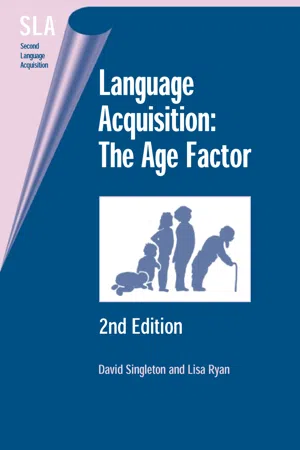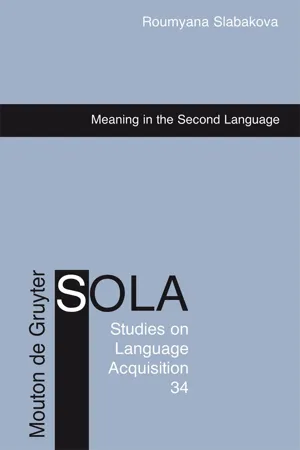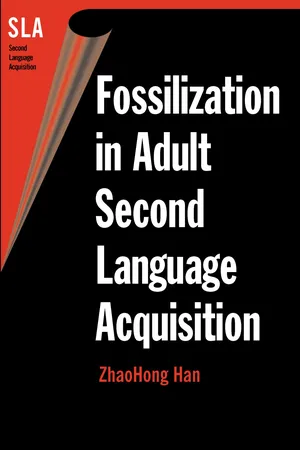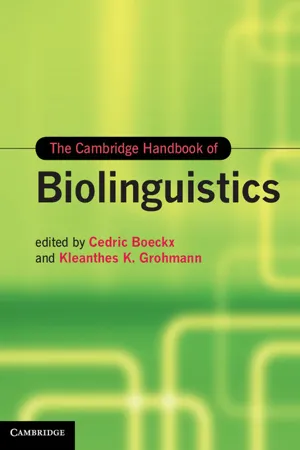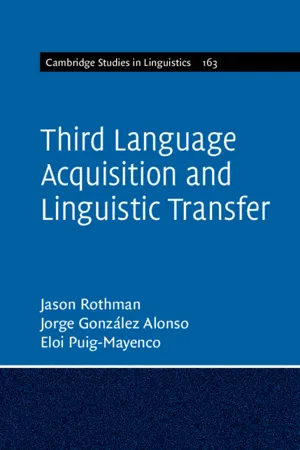Languages & Linguistics
Critical Period
A critical period refers to a specific time in an individual's development during which they are most receptive to acquiring certain skills or knowledge. In the context of language acquisition, it is believed that there is a critical period during childhood when individuals are most adept at learning languages, and that this ability diminishes with age. This concept has significant implications for language education and bilingualism.
Written by Perlego with AI-assistance
Related key terms
1 of 5
11 Key excerpts on "Critical Period"
- eBook - ePub
Language Acquisition
The Age Factor
- David Singleton, Lisa Ryan(Authors)
- 2004(Publication Date)
- Multilingual Matters(Publisher)
Chapter 3
The Critical Period Hypothesis: L1-related Evidence
Introductory
The popularly held view that there is a ‘Critical Period’ for language development is not generally subjected to more than rather superficial scrutiny. Most adults simply take it for granted, for example, that children are of their nature equipped to learn a foreign language with much less effort and in a generally more competent manner than they themselves are able to manage. Introductory psychology texts often treat the matter in a similarly axiomatic fashion but endow the assumptions they make with scientific credentials by introducing concepts and terminology from such domains as neuropsychology and nativist linguistics. This is not to say that the Critical Period Hypothesis is without its critics. Indeed, the question of whether there is a Critical Period for language development has generated fierce debate among researchers and continues to do so. As was indicated in Chapter 1 , the discussion has both a theoretical and a practical dimension and is of interest to L1 acquisition researchers and L2 acquisition researchers alike. For some theoreticians the Critical Period Hypothesis is important because the notion of maturational constraints on language acquisition is seen as related to the idea that language development is underpinned by special bioprogramming. In the more practical sphere of language education, the Critical Period Hypothesis has ramifications with respect to decision-making about the starting point for the introduction of L2 instruction in schools. The L2 issues will be discussed in detail in Chapters 4 and 6 - eBook - PDF
- Roumyana Slabakova(Author)
- 2008(Publication Date)
- De Gruyter Mouton(Publisher)
2. Critical Periods: Possible biological explanations In the previous section, we focused on the visible effects of the timing of language acquisition onset: what happens when L1 or L2 acquisition starts at birth, or after puberty. In this section, we will look at some biological explanations for these visible effects. The Critical Period Hypothesis rests on the assumption that the qualitative change in the language-learning ab-ilities of children and adults is the result of maturational changes in the brain structures that are used to learn and/or process language. Lenneberg’s original idea was to attribute the Critical Period for first language acquisi-tion to progressive brain lateralization. It has also been hypothesized that, as the brain matures, it becomes “less plastic”, in the sense that neurons are less likely to make new connections, and that reduced connectivity impedes L2 learning (Long, 1990; Patkowski, 1980). Some researchers have argued that we should see this brain maturation as the process of myelination of cortical neurons (Pulvermüller and Schumann, 1994). However, Gregg and Eubank (1999) submit that most of the evidence for a Critical Period in nat- Critical Periods: biological explanations 5 ural development comes from non-human species and that this evidence is far from complete. Critical Periods in biological development have been recognized by bi-ologists for over a century. Beginning with the behavioral observations of Konrad Lorenz (1958), this concept has profoundly influenced psycholo-gists, philosophers, parents, and educators. Hensch (2004), in a recent re-view of Critical Period regulation in biological development, describes well studied and less well-studied Critical Period effects. Examples include the classical case (Lorenz, 1958) of the filial imprinting of certain precocial birds on a parental figure hours after hatching. - ZhaoHong Han(Author)
- 2004(Publication Date)
- Multilingual Matters(Publisher)
The primary sensory and motor areas myelinate early, within the first 12 months, suggesting that neurons of primary cortices are the first to reduce their potential for making new synapses and for modifying established ones . . . higher-order association cortices (e.g., the prefrontal cortex and the angular gyrus) myelinate much later and even in the adult brain relatively few myelinated (glial wrapped) axons connect these regions of the left and right hemisphere . . . suggesting that even late in life they include a high number of unmyelinated neurons and show a high level of plasticity . . . Around puberty, all cortical areas, except perhaps the higher-order association cortices, have reached their full level of myelination. Accordingly, neurons in the perisylvian language cortex are left with reduced plasticity around puberty, the time after which language learning will lead to reduced grammatical abilities. (1994: 711)Long (1990), after surveying a large number of Critical Period studies, very concretely suggests that the Critical Period for phonology begins to offset at age 6, but that for morphology and syntax it ends at age 15. This necessarily predicts less success for adult learners in acquiring native-like phonological competence but more in acquiring L2 morphosyntax.The modular nature in the sense of 'multiple Critical Periods' is not only true of linguistic domains such as phonology and morphosyntax, but also of subsystems within each of these domains, as will be shown in the next section as we explore CP effects.Critical Period Effects on Language Learning
Of the neurological processes that have been considered as underlying the Critical Period, lateralization appears to have received the most attention, since progressive lateralization of language functions to the dominant left hemisphere is widely taken to be concomitant with the gradual loss of neural plasticity.Plasticity, in the eyes of many, is synonymous with sensitivity and flexibility. Scovel (1988), for example, defines it as the overall ability of the brain to program and process new patterns of behavior quickly and efficiently, and to relocate this ability to different areas of the brain should there be congenital damage or injury incurred after birth. High sensitivity to external stimuli is further correlated with success. Early learners are assumed to possess high sensitivity, and hence are successful in learning. Late learners (e.g., adults), on the other hand, have a lowered sensitivity – being less responsive to environmental influences such as input from the target language – and hence are less successful. As Eubank and Gregg (1999: 90) aptly put it, 'once the period is past, linguistic input ceases to have an instructional effect with regard to those aspects [of language]'. Of relevance to note, this proposition is consistent with findings from a number of recent neurophysiological experiments with early and late bilinguals that are conducted via Event-related Brain Potentials (ERPs), a technique for measuring electrical activity in different areas of the brain (see, e.g., Weber-Fox & Neville, 1999).- eBook - PDF
- Josue M. Gonzalez, Josué M. González(Authors)
- 2008(Publication Date)
- SAGE Publications, Inc(Publisher)
Language Learning, 30, 449–472. Penfield, W., & Roberts, L. (1959). Speech and brain mechanisms. Princeton, NJ: Princeton University Press. Scovel, T. (1988). A Time to speak: A psycholinguistic inquiry into the Critical Period for human language. Rowley, MA: Newbury House. Seliger, H. W. (1978). Implications of a multiple Critical Periods hypothesis for second language learning. In W. Ritchie (Ed.), Second language acquisition research: Issues and implications (pp. 11–19). New York: Academic Press. Singleton, D. (2005). The Critical Period Hypothesis: A coat of many colors. International Review of Applied Linguistics, 43, 269–285. Singleton, D., & Lengyel, Z. (Eds.). (1995). The age factor in second language acquisition. Clevedon, UK: Multilingual Matters. L INGUISTIC M ATURITY T HEORY See L EARNING A L ANGUAGE , B EST A GE L INGUISTICS , AN O VERVIEW One of the central academic disciplines underlying the collective knowledge base of bilingual education is that of linguistics. Linguistics can be defined, in the broadest terms, as the scientific description of human language. Tony Howatt explains in the introduction to the Linguistics Encyclopedia (2nd ed.) that serious study of the human capacity for language is presumed to have begun in the first literate human societies (e.g., Mesopotamia, Northern India, China, and Egypt). However, the roots of Western linguistics as a specific area of scientific study date back to the 19th century. Two central questions have shaped the field since that time: First, what is the nature of human lan-guage; and second, what is involved in the study of human language? This entry addresses those two questions by way of providing an overview of the science of linguistics. Nature of Language It is difficult to capture, succinctly, the myriad ways in which different traditions of linguistic study conceive of the nature of human language. - eBook - PDF
- Cedric Boeckx, Kleanthes K. Grohmann(Authors)
- 2013(Publication Date)
- Cambridge University Press(Publisher)
If first and second lan- guage acquisition result in qualitative differences in this domain, as I claim to be the case, this provides strong support for the assumption that Critical Period effects characterize successive acquisition in a similar fashion as first language development. This does not, of course, exclude the possibil- ity that other domains of grammar are subject to such constraints as well. A second point which needs to be considered when attempting to define more precisely the notion of “Critical Period” concerns the fact that no current theorizing, either in linguistics or in cognitive psychology or the neurosciences, obliges us to assume that the grammatical domains subject to maturational changes are all affected simultaneously, during a single 76 J Ü R G E N M . M E I S E L age period. Quite to the contrary, past research demonstrates that phonol- ogy, morphology, and syntax follow distinct developmental agendas; see, for example Long (1990) or Eubank and Gregg (1999). In fact, assuming that linguistic development proceeds through sensitive phases during which the LAD is optimally prepared for the integration of new information into developing grammars, we must expect to find asynchronous development even within these subcomponents of grammar. Consequently, rather than postulating one Critical Period for language acquisition, a more plausible hypothesis is that grammatical development is characterized by several sensitive phases; see Locke (1997), among others. If it can be shown that sensitive phases cluster at different points of linguistic development, each of these clusters can be argued to constitute the equivalent of one of multiple Critical Periods; cf. Seliger (1978). The third point concerns the nature of these sensitive phases. Notions like “Critical Period” or “sensitive phase” do not necessarily imply an abrupt loss of a previously available capacity, as if this capacity was suddenly switched off; cf. - eBook - PDF
- Marianne Nikolov(Author)
- 2009(Publication Date)
- De Gruyter Mouton(Publisher)
These findings, however, do not mean that ELL is a waste of time. Studies provide insights into complex ways of how young learners develop and o¤er an opportunity to discuss research methodology and areas for further research. As will be argued, the ad-vantages and outcomes of an early start need to be analyzed in the spe-cific contexts where young learners and their teachers interact with one another in classrooms in hugely varying conditions. Therefore, further research is necessary indeed. 1. The age factor and the Critical Period Hypothesis 1.1. The Critical Period Hypothesis Young learners are widely perceived to aquire languages in a qualita-tively di¤erent way from adolescents and adults. Children before a cer-tain age seem to pick up a new language with ease and success, whereas older learners often fail to do so. Discussions on the age factor tend to focus on the Critical Period Hypothesis (CPH) for language (e.g., Scovel 1988, 2000; Singleton 2001, 2005). The CPH has been a hotly debated research area not only in second language acquisition (SLA) research, but also in linguistic theory and cognitive science (Hernandez, Ping and MacWhinney 2005; Paradis 2004; Pinker 1994; McWhinney 2005). Some researchers argue that di¤erent critical, or sensitive, periods char-acterize language acquisition in di¤erent linguistic areas, and ‘‘the exis-tence, or not, of one or more sensitive periods for SLA has major impli-cations for the validity of any SLA theory’’ (Long 2005: 311). An important distinction has been confirmed in recent cognitive and neurobiological explanations of SLA reflecting a dual procedural/declara-tive dimension widely accepted in cognitive science (e.g., McWhinney 2005; Paradis 2004; Ullman 2001). Two systems exist side by side: a rule-based analytic procedural system, and a formulaic, exemplar-based declarative system (Skehan 1998). - Jason Rothman, Jorge González Alonso, Eloi Puig-Mayenco(Authors)
- 2019(Publication Date)
- Cambridge University Press(Publisher)
To begin, the entire notion of a Critical Period was originally predicated on the strong belief that the modular mind was deeply affected by the loss of neurological plasticity after puberty; that is, non-pathological, morphological changes to the structure of the adult brain affecting its ability to reorganize or redistribute functions as needed. However, we know now that the brain remains much more malleable throughout the lifespan than was previously claimed, meaning that there is no sharp decline in neurological plasticity culminating around puberty (see Fuchs & Flügge, 2014, for review). Evidence against (a strong version of) a Critical Period affecting sequential adult language acquisition comes from research showing that there are (i) highly successful older learner exceptions to the general L2 acquisition out- come and (ii) significant behavioral and neurolinguistic/processing data that fail to show qualitative differences in the acquisition outcomes and/or real-time processing between adult native and nonnative speakers, particularly in domains of the L2 grammar for which measurable Critical Period effects are predicted. 1.2 Adult L2 Acquisition: Potential and L1 Effects 15 It is possible, however, that adults simply no longer have the same abilities for language acquisition as children; that is, the linguistic and/or cognitive learning mechanisms that guide child acquisition are no longer available – at all or to the same degree – after a specific time window in early adulthood (e.g., Abrahamsson & Hyltenstam, 2009; Bley-Vroman, 1989, 2009; Bylund, Abrahamsson, & Hyltenstam, 2012; Bylund, Hyltenstam, & Abrahamsson, 2013; Graena & Long, 2013; Hawkins & Casillas, 2008; Hawkins & Chan, 1997; Long, 2005; Meisel, 2011; Tsimpli & Dimitrakopoulou, 2007). Successes in adult L2 performance are acknowledged by researchers advocating a biologically induced age-related explanation for some L1 versus L2 differ- ences.- Alene Moyer(Author)
- 2004(Publication Date)
- Multilingual Matters(Publisher)
Chapter 1Contextualizing Critical Period Inquiry
Coming into contact with a foreign language means hardship whichusually brings euphoria quickly to an end, making it a short episode forthe individual - and also for groups and nations.Konrad Ehlich, 1994[A second] language emerges through necessity ... because I want it,urgently want it, and because I urgently attend to it.Peter Bichsel, 1995 [translation mine]The Problems of Scope and Classification
The field of second language acquisition (SLA) has long sought relevant factors to explain differential attainment for early and late learners. Since the appearance of Lenneberg’s Biological Foundations of Language (1967), the idea of a Critical Period for language learning has guided a great deal of the research on second language acquisition.1 Though Lenneberg made little specific mention of SLA, his Critical Period hypothesis has evolved into a full-blown theory for the field, often assumed to be a ‘unitary account of non-native like outcomes’ (Birdsong, 1999: 9). Still, the question remains why late language learners typically perform in notably ‘non-native’ ways. In the search for answers, we too rarely recognize the highly individual and complex nature of the endeavor. This is an especially salient issue given that SLA is most often an uninstructed, i.e. non-classroom, process among immigrants to foreign lands who face harsh social and economic conditions, possibly remaining culturally isolated for years.Given this context of great challenge, many fall far short of a native speaker ideal, while others succeed beyond all expectations. By all accounts, we cannot yet explain either extreme of the success scale: entrenched fossilization and exceptional learning. The empirical evidence points to no specific faculty or mechanism in either the neurological or cognitive realm to explain exceptional performance in L2 (Obler, 1989; Schneidermann, 1991 as cited in Birdsong & Molis, 2001). Why, then, do more learners not- eBook - PDF
- Fredric W. Field(Author)
- 2017(Publication Date)
- Red Globe Press(Publisher)
Any educator familiar with the challenges faced by rural folks, the working-class, women, indigenous peoples, and linguistic minori-ties knows what a daunting task this can be. Anyone who claims to teach critical literacy skills must be familiar with the kinds of knowledge that critical reading entails, qualitatively as well as quantitatively. It goes much further than merely C 46 K e y C o n c e p t s i n B i l i n g u a l i s m teaching a child how to read and write and to achieve functional literacy—the end-point of many English-only programs is just that, functional literacy. See biliteracy, cultural literacy, literacy, preliteracy training . Critical (or sensitive) period Refers to a period in the life cycle when there is greater sensitivity to certain kinds of stimuli, an inborn or innate advantage. There is popular support for the idea that children have a special talent or propensity for language that older learners do not have. Among researchers in SLA, however, this has been a constant source of controversy, particularly in view of recent positions of the domain-specific or domain-general views of language. See Critical Period Hypothesis, domain . Critical Period Hypothesis (CPH) The hypothesis stating that there is a special or sensitive period in development in which a child has a particularly heightened ability to acquire language. Developed by the biologist Eric Lenneberg, the hypothesis seemed to fit with most people’s intuitions and the idea that children seem to have a unique ability to just grab languages out of the air (with no teachers, no textbooks, and no testing). However, critics have questioned what empirical data says to test the hypothesis. - Kenneth Hyltenstam, Inge Bartning, Lars Fant(Authors)
- 2018(Publication Date)
- Cambridge University Press(Publisher)
1 Age Effects on Language Acquisition, Retention and Loss Key Hypotheses and Findings Niclas Abrahamsson, Kenneth Hyltenstam and Emanuel Bylund 1.1 Introduction One of the longest-standing scientific debates on language acquisition concerns the relationship between age of first exposure and language development, the big divide being between proponents and opponents of the idea of one or several Critical Period(s) for language. While being perhaps the most- observed language acquisition phenomenon among laypeople, ironically, chil- dren’ s success in second language (L2) acquisition relative to that of adults is still, fifty years after the publication of Lenneberg’ s (1967) Critical Period Hypothesis (CPH), a highly contested issue among scholars of linguistics, cognitive psychology, second language acquisition and bilingualism. Considering the boldness of a biologically underpinned hypothesis on human language acquisition that assumes maturational changes to be the cause of child–adult differences, it should have come as no surprise to Lenneberg (nor anyone else) that the CPH was to become subject to falsification, and quite intensively so. The earliest challenges were based on an entirely unrestricted interpretation of the hypothesis espoused by some researchers (e.g. Asher & Price 1967; Olson & Samuels 1973; Snow & Hoefnagel-Höhle 1977, 1978), who compared the language performance of small children, older children, adolescents and/or adults either in a ‘teach and test’ format in laboratory-like settings, sometimes with target structures from languages previously unknown to the participants, or for their initial language learning achievements during their first few months of residence in new language settings. Because adoles- cent and adult learners outperformed child learners, and because older children did better than very young children in these extremely time-constrained and sometimes artificial learning situations, the CPH was considered falsified.- eBook - PDF
- Nancy Ogden, Michael Boyes, Evelyn Field, Ronald Comer, Elizabeth Gould(Authors)
- 2021(Publication Date)
- Wiley(Publisher)
This allowed him to study, in detail, the time-worms associated with the birth of each word in his son’s vocabulary and focus in detail on the social contexts in which those word births occurred. 354 CHAPTER 9 Language and Thought spent her entire life in isolation chained to a potty chair (see photo). She was rarely spoken to except in a punitive way (“stop it”). Her father communicated with her mostly by grunting and barking. At age 13, when her mother finally left the father, Genie had been exposed to almost no speech and appeared to be nearly mute. Her vocabulary consisted of about 20 words. Age 13 is after the time at which most researchers had assumed that the Critical Period for language acquisition is over. This assumption is based on the fact that after this age, people learn new languages with greater difficulty and typically speak their second languages with accents. Because Genie was 13 years old at the time when she was rescued, she was a tragic test case of whether a Critical Period for language exists. During the years that followed her rescue, Genie received extensive, interactive language training. Although she did initially show progress in expanding her vocabulary, it was always limited and didn’t include the acquisition of grammatical rules. Unfortunately, Genie’s vocabu- lary regressed even further when she was under stress. Genie’s experiences tended to provide support for the theory that a sensitive period for language learning does exist. Although the case of Genie seems to support the language Critical Period theory, it’s impor- tant to keep in mind that Genie was not only deprived of language, but also subjected to extreme physical and emotional abuse that may have contributed significantly to her inability to learn (Sylvestre, Bussières, & Bouchard, 2016).
Index pages curate the most relevant extracts from our library of academic textbooks. They’ve been created using an in-house natural language model (NLM), each adding context and meaning to key research topics.
